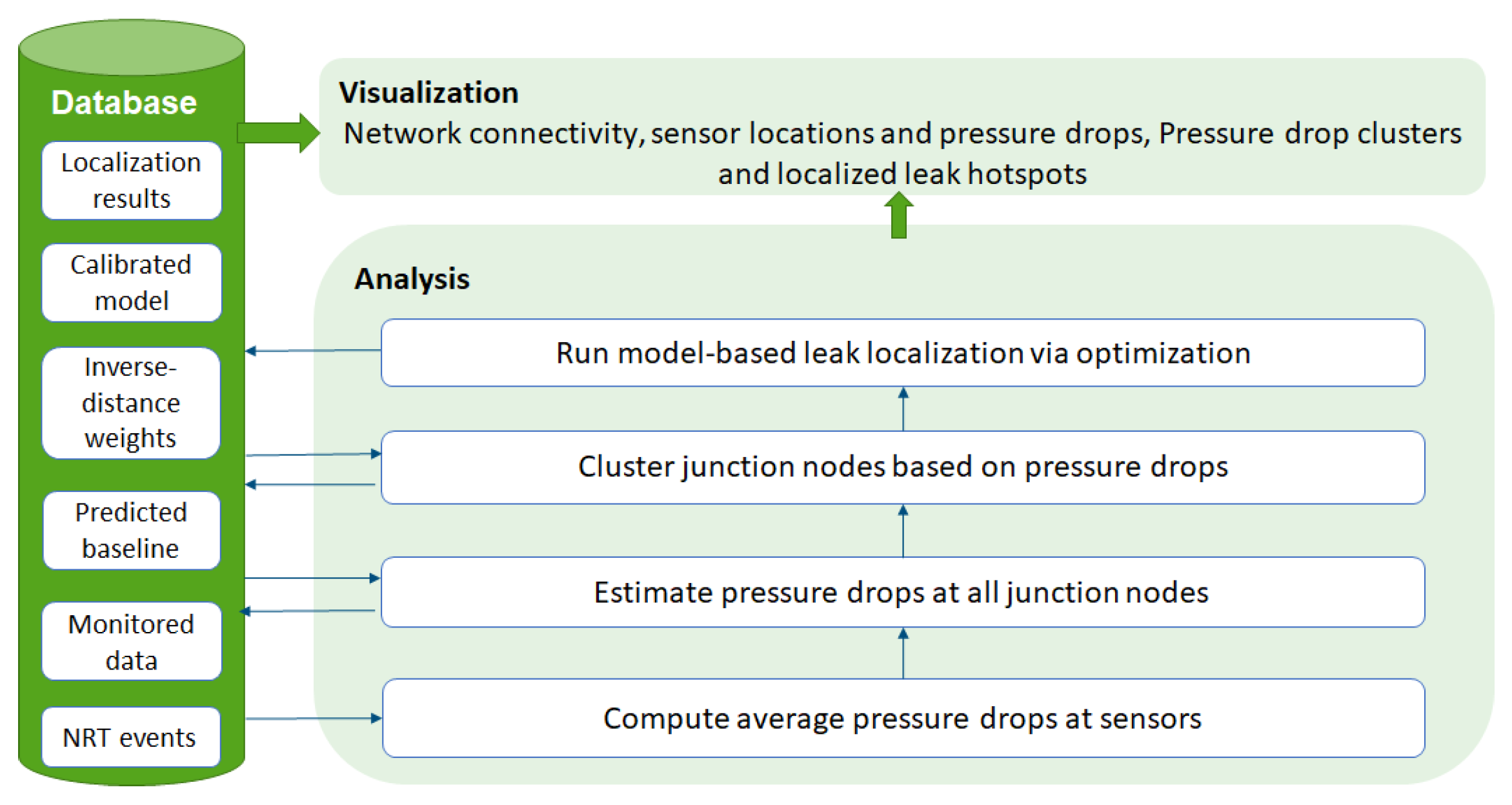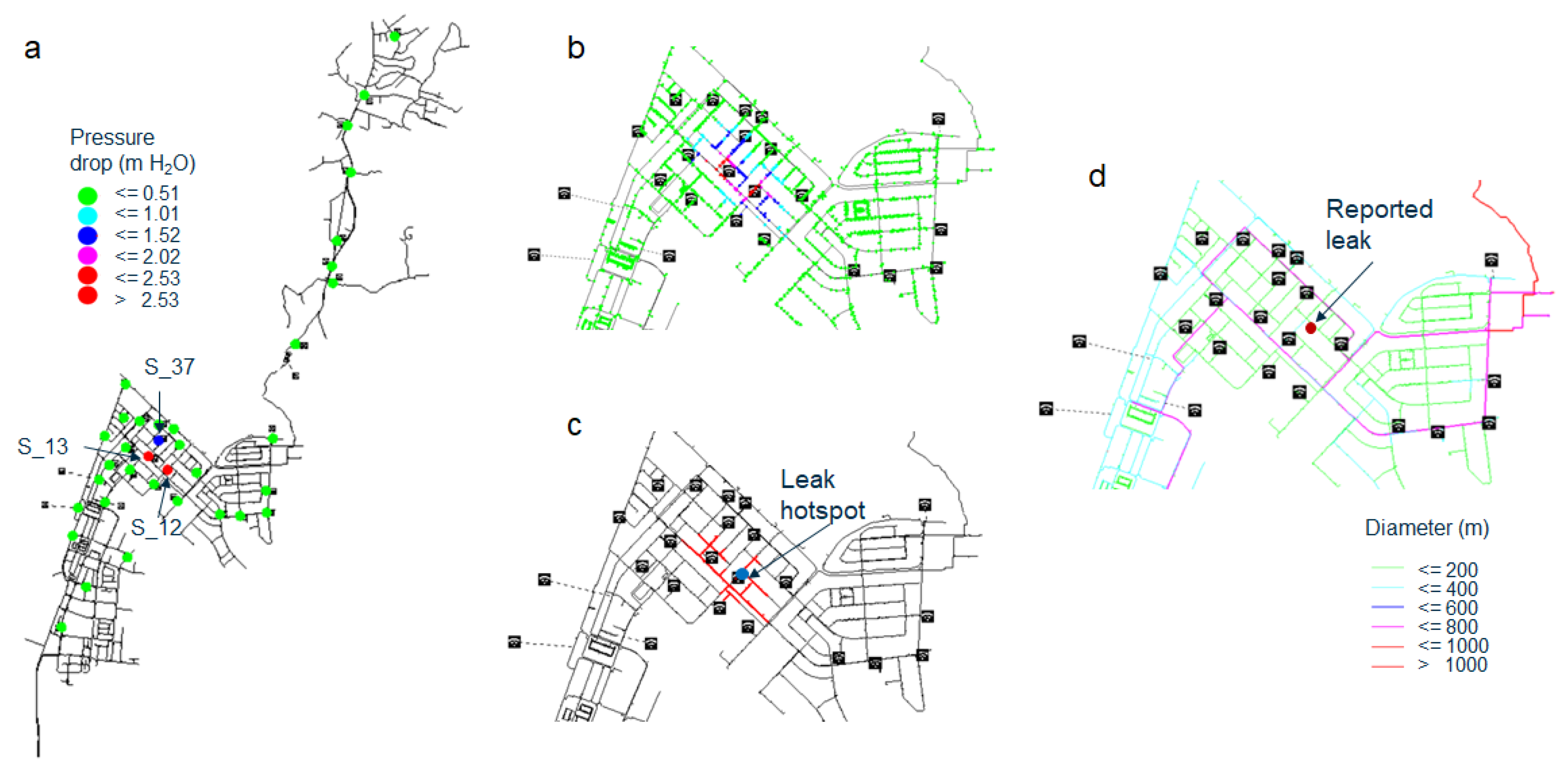Anomaly Localization by Applying Data-Driven Analysis and Parallel Optimization of Hydraulic Model Calibration †
Abstract
1. Introduction
2. Methodology
3. Applications
Author Contributions
Funding
Institutional Review Board Statement
Informed Consent Statement
Data Availability Statement
Conflicts of Interest
References
- Wu, Z.Y.; Chew, A.; Meng, X.; Cai, J.; Pok, J.; Kalfarisi, R.; Lai, K.C.; Hew, S.F.; Wong, J.J. Data-driven and model-based framework for smart water grid anomaly detection and localization. AQUA Water Infrastruct. Ecosyst. Soc. 2022, 71, 31–41. [Google Scholar] [CrossRef]
- Chew, A.W.Z.; Wu, Z.Y.; Walski, T.; Meng, X.; Cai, J.; Pok, J.; Kalfarisi, R. Daily model calibration with water loss estimation and localization using continuous monitoring data in water distribution networks. J. Water Resour. Plan. Manag. 2022, 148, 04022019. [Google Scholar] [CrossRef]
- Li, Q.; Wu, Z.Y.; Rahman, A. Evolutionary deep learning with extended Kalman filter for effective prediction modeling and efficient data assimilation. J. Comput. Civ. Eng. 2019, 33, 04019014. [Google Scholar] [CrossRef]
- Wu, Z.Y.; Sage, P.; Turtle, D. Pressure-dependent leak detection model and its application to a district water system. J. Water Resour. Plan. Manag. 2010, 136, 116–128. [Google Scholar] [CrossRef]
- Wu, Z.Y.; Wang, Q.; Butala, S.; Mi, T.; Song, Y. Darwin Optimization User Manual; Bentley Systems, Incorporated: Watertown, CT, USA, 2012. [Google Scholar]


| Starting Date of Detected Leak | Date of Reported Leak | Clustered Search Areas Covering the Ground-Truth Leak? | Distance of Localized Hotspot to Ground Truth (m) |
|---|---|---|---|
| 16 August 2022 | 19 August 2022 | Yes | 250 m |
| 13 September 2022 | 14 September 2022 | Yes | 220 m |
Disclaimer/Publisher’s Note: The statements, opinions and data contained in all publications are solely those of the individual author(s) and contributor(s) and not of MDPI and/or the editor(s). MDPI and/or the editor(s) disclaim responsibility for any injury to people or property resulting from any ideas, methods, instructions or products referred to in the content. |
© 2024 by the authors. Licensee MDPI, Basel, Switzerland. This article is an open access article distributed under the terms and conditions of the Creative Commons Attribution (CC BY) license (https://creativecommons.org/licenses/by/4.0/).
Share and Cite
Zhang, A.H.; Cao, F.; Chew, A.W.Z.; Wu, Z.Y.; Kalfarisi, R.; Meng, X.; Pok, J.; Wong, J.M.; Lai, K.C.; Seow, L.; et al. Anomaly Localization by Applying Data-Driven Analysis and Parallel Optimization of Hydraulic Model Calibration. Eng. Proc. 2024, 69, 6. https://doi.org/10.3390/engproc2024069006
Zhang AH, Cao F, Chew AWZ, Wu ZY, Kalfarisi R, Meng X, Pok J, Wong JM, Lai KC, Seow L, et al. Anomaly Localization by Applying Data-Driven Analysis and Parallel Optimization of Hydraulic Model Calibration. Engineering Proceedings. 2024; 69(1):6. https://doi.org/10.3390/engproc2024069006
Chicago/Turabian StyleZhang, Ashley Hui, Fred Cao, Alvin Wei Ze Chew, Zheng Yi Wu, Rony Kalfarisi, Xue Meng, Jocelyn Pok, Juen Ming Wong, Kah Cheong Lai, Lennis Seow, and et al. 2024. "Anomaly Localization by Applying Data-Driven Analysis and Parallel Optimization of Hydraulic Model Calibration" Engineering Proceedings 69, no. 1: 6. https://doi.org/10.3390/engproc2024069006
APA StyleZhang, A. H., Cao, F., Chew, A. W. Z., Wu, Z. Y., Kalfarisi, R., Meng, X., Pok, J., Wong, J. M., Lai, K. C., Seow, L., & Wong, J. J. (2024). Anomaly Localization by Applying Data-Driven Analysis and Parallel Optimization of Hydraulic Model Calibration. Engineering Proceedings, 69(1), 6. https://doi.org/10.3390/engproc2024069006






